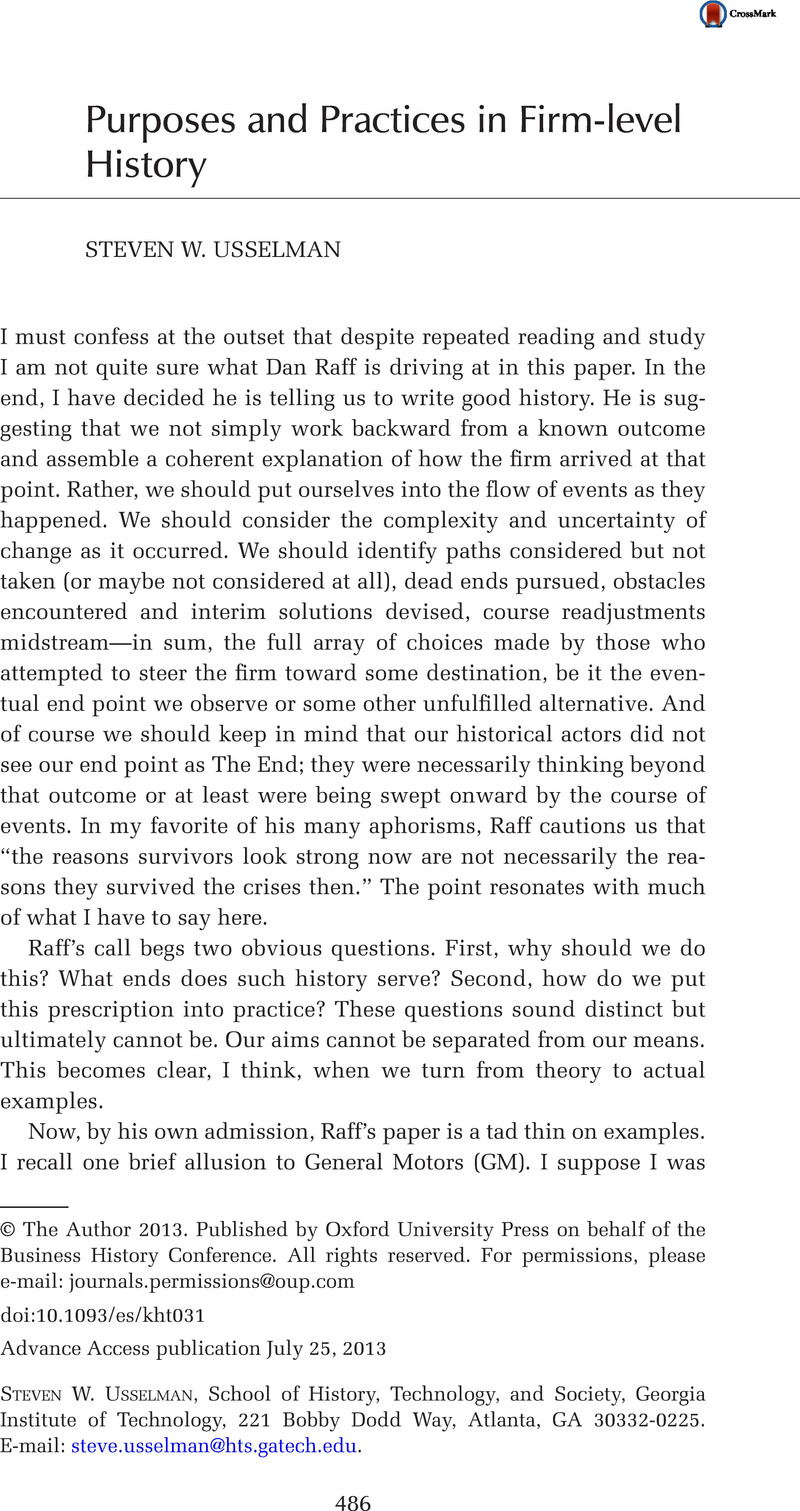Article contents
Purposes and Practices in Firm-level History
Published online by Cambridge University Press: 18 February 2015
Abstract

- Type
- Article
- Information
- Copyright
- Copyright © The Author(s) 2013. Published by Cambridge University Press on behalf of the Business History Conference. All rights reserved.
References
1. McPherson, James, Battle Cry of Freedom: The Civil War Era, New York: Oxford University Press, 2003.Google Scholar
2. Chandler, Alfred D. Jr., The Visible Hand: The Managerial Revolution in American Business, Cambridge, MA: Harvard University Press, 1977 Google Scholar; Lamoreaux, Naomi R., Raff, Daniel M. G., and Temin, Peter, “Beyond Markets and Hierarchies: Toward a New Synthesis of American Business History,” American Historical Review 108, no. 2 (2003): 404–33CrossRefGoogle Scholar; Scranton, Philip, “Diversity in Diversity: Flexible Specialization and American Industrialization, 1880-1930,” Business History Review 65 (1991): 27–90 CrossRefGoogle Scholar and Endless Novelty: Specialty Production and American Industrialization, 1865-1925, Princeton: Princeton University Press, 1997; Langlois, Richard N., “Modularity in Technology and Organization,” Journal of Economic Behavior and Organization 49, no. 1 (2002): 19–37 CrossRefGoogle Scholar; and Lazonick, William, Sustainable Prosperity in the New Economy?: Business Organization and High-Tech Employment in the United States, Kalamazoo: W. J. Upjohn Institute for Employment Research, 2009.CrossRefGoogle Scholar For an exchange among Chandler, Langlois, and Lamoreaux, Raff, and Temin, see Enterprise and Society 5, no. 3 (2004): 355–403 and 6, no. 1 (2005): 134–37.
3. Galambos, Louis, “The Emerging Organizational Synthesis in Modern American History,” Business History Review 44, no. 3 (1970): 279–90CrossRefGoogle Scholar; “Technology, Political Economy, and Professionalization: Central Themes of the Organizational Synthesis,” Business History Review 57, no. 4 (1983): 471–93; and “Recasting the Organizational Synthesis: Structure and Process in the Twentieth and Twenty-First Centuries,” Business History Review 79, no. 1 (2005): 1–38.
4. Except maybe for Steven Klepper, the most radical evolutionist and indefatigable researcher among us, who has authored a pathbreaking series of authoritative studies on firm entry and exit in automobiles and other industrial sectors; cf. his “Entry, Exit, Growth, and Innovation over the Product Life Cycle,” The American Economic Review 86, no. 3 (June 1996): 562–83.
5. Lipartito, Kenneth, “Rethinking the Invention Factory: Bell Laboratories in Perspective,” in The Challenge of Remaining Innovative: Insights from Twentieth-Century American Business, eds. Clarke, Sally H., Lamoreaux, Naomi R., and Usselman, Steven W., Stanford, CA: Stanford University Press, 2009, 132–59.Google Scholar
6. McKenna, Christopher, “Mementos: Looking Backward at the Honda Motorcycle Case, 2003–1973,” in Clark, Lamoreaux, and Usselman, , The Challenge of Remaining Innovative, 219–39.Google Scholar See also his, The World’s Newest Profession: Management Consulting in the Twentieth Century, New York: Cambridge University Press, 2006.
7. The anecdotes and observations that follow draw primarily upon Usselman, Steven W., “Learning the Hard Way: IBM and the Sources of Innovation in Early Computing,” in Financing Innovation in the United States, 1870 to the Present, eds. Lamoreaux, Naomi R. and Sokoloff, Kenneth L., Cambridge, MA.: MIT Press, 2007, 317–63CrossRefGoogle Scholar; and “Unbundling IBM: Antitrust and the Incentives to Innovation in American Computing,” in The Challenge of Remaining Innovative, eds Clark, Lamoreaux, and Usselman, 249–79.
8. Usselman, Steven W., “IBM and Its Imitators: Organizational Capabilities and the Emergence of the International Computer Industry,” Business and Economic History 22, no. 2 (1993): 1–35.Google Scholar
9. Norberg, Arthur Lawrence, Computers and Commerce: A Study of Technology and Commerce at Eckert-Mauchly Computer Company, Engineering Research Associates, and Remington Rand, 1946–1957, Cambridge, MA: MIT Press, 2006.Google Scholar
10. McCraw, Thomas K, American Business Since 1920: How It Worked, 2d ed., Wheeling, Illinois: Harlan Davidson, 2009.Google Scholar
11. For a recent synthesis focused explicitly on this theme, see “Introduction,” in The Challenge of Remaining Innovative, eds. Clark, Lamoreaux, and Usselman, 1–35.
- 1
- Cited by


